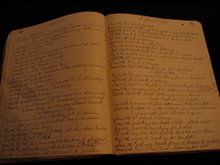Sunday, April 29, 2007
3rd Land Run
The third land run opened the Cheyenne-Arapaho reservation on April 19,1892. The eastern half, which contained most of the Indian allotments, filled quickly. The western half was used primarily for grazing.
Saturday, April 21, 2007
Second Oklahoma Land Run
The lands of the Iowa, Sac, and Fox Indians opened for non-Indian settlement on September 22, 1891. Approximately 20,000 homeseekers rushed for 7,000 quarter-sections of land. Each quarter-section is 160 acres.
Monday, April 9, 2007
Guthrie, Oklahoma
When the sun rose April 22,1889 Guthrie, Oklahoma consisted of a water tank, two section houses, and a train depot. By the end of the day, the first capitol of Oklahoma was a city of tents with a population of 10,000 to 15,000 people.
Saturday, March 24, 2007
Oklahoma City Beginnings
On the morning of April 22, 1889, Oklahoma City was a treeless prairie around a train stop.Lathered horses and multiple double-engined 24-car trains poured in all day. By night-fall, Oklahoma Station was a community of more than 10,000--a city born in a day.
Saturday, March 17, 2007
Unassigned Lands
In the first land run of 1889, most of the land offered had not been assigned to any tribe. Ten years earlier in 1879, Elias C. Boudinot, a prominent mixed-blood Cherokee lawyer, discovered this fact. He created a fire storm when he published a letter urging the opening of the Unassigned Lands to non-Indians. Thought to be working with the railroads and the boomers, he was called a traitor by his people.
Labels:
boomers,
Cherokee,
Elias C. Boudinot,
lawyer,
mixed-blood,
non-Indians,
railroads,
traitor,
Unassigned Lands
Sunday, March 4, 2007
First Oklahoma Land Run

April 22, 1889, an estimated 50,000 pioneers crowded along the borders of the Unassigned Lands to make the first land run in Oklahoma history. The race began at high noon. They came by train, horse, buggy, and bicycle to win 160 acres of their very own.
Labels:
1889; pioneers,
acres,
April 22,
history,
Oklahoma,
Unassigned Lands
Sunday, February 25, 2007
Farming in Oklahoma
About 900 A.D. Indians of Oklahoma grew beans, corn, and pumpkins. In the 1850's mixed-blood plantation owner Choctaw Robert M. Jones cultivated more than 5,000 acres and shipped his cotton to New Orleans on his own steam boats.
Labels:
Choctaw,
cotton,
Indians,
mixed-blood,
New Orleans,
plantation owners,
Robert Jones,
steam boats
Saturday, February 17, 2007
Military Posts
To control the Plains tribes after the Civil War, the government established a chain of forts from the Dakotas to Texas. In the Indian Territory the new western outposts were Fort Sill, Fort Reno, and Camp Supply. From these bases of operation, troops tacked and battled elusive Indians, chased and arrested horse thieves, and found and drove out the persistent armies of boomers led by David L. Payne and William Couch. In 1889 troops from Fort Reno supervised the land run.
Labels:
boomers,
Camp Supply,
Civil War,
Dakota,
David L. Payne,
Fort Scott,
Fort Sill,
forts,
horse thieves,
Indian Territory,
Plains Tribes,
Reno,
Texas,
William Couch
Sunday, February 11, 2007
General Allotment
The General Allotment Act, passed by Congress in 1887, was the beginning of the end for tribal sovereignty and reservations in the Indian Territory. After the government reached agreements with a tribe, heads of families received 160 acres of land, while single individuals under 18 received 80 acres. Allottees were able to choose which land they wanted. After the allotment was completed, surplus lands were purchased from the tribes and made a part of the public domain, thus paving the way for the numerous land openings. As each parcel was opened, it was added to Oklahoma Territory, important steps in the state-making process.
Saturday, February 3, 2007
CATTLE TRAILS ACROSS OKLAHOMA
Longhorn cattle trails from Texas to Kansas railheads spanned the era from 1866 to 1889. Four primary trails cut through the Indian Territory: the East Shawnee Trail, the West Shawnee Trail, the Chisholm Trail, and the Great Western or Dodge City Trail.
Subscribe to:
Posts (Atom)

